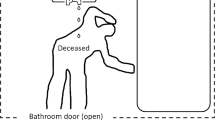Summary
Several poisonings by diphenhydramine were reported shortly after it had been introduced as an antihistamine in 1945. In the Federal Republic of Germany its combination with 8-chlorotheophylline (dimenhydrinate) is available as a hypnotic without prescription. Replacing the dangerous diethylpentenamide diphenhydramine is a drug which is also often abused.
Fatal poisonings, suicide attempts, and traffic accidents were increasingly observed. In seven cases drug-influenced road users caused traffic accidents. We observed blood concentrations of diphenhydramine as high as in four cases of clinically treated patients after ingestion of large doses. This indicates a serious drug abuse.
The measurement of the concentration of diphenhydramine and its major metabolite (diphenmethoxy acetic acid) in blood and urine is a means of recognizing chronic use and misuse of diphenhydramine. As the metabolite accumulates in blood one may find an elevated level after multiple dosing. Shortly after taking a single dose no or only low metabolite concentration is found. The concentration of diphenhydramine and its metabolite was measured in several fatal cases. In one of these cases the concentration in body fluids and tissues was in a range not observed until now.
Zusammenfassung
Kurz nach der Einführung des Wirkstoffes (1945) konnten Vergiftungen mit Diphenhydramin beobachtet werden. Seit Diphenhydramin, zusammen mit 8-Chlortheophyllin als Dimenhydrinat im Handel, anstelle des gefährlicheren Diethylpentenamid als rezeptfreies Schlafmittel angeboten wird, stiegen auch die Zahlen von Vergiftungen und Verkehrsunfällen unter Diphenhydramin-Einfluß. Der Vergleich von vier klinisch behandelten und überlebenden Patienten mit sieben unter Diphenhydramin-Einfluß verunfallten Verkehrsteilnehmern zeigt, daß hier massive Intoxikationen bei erheblichem Tablettenmißbrauch vorgelegen haben. Aus den Verhältnissen der Diphenhydramin-Konzentration in Blut und Urin sowie den Konzentrationen der als Hauptstoffwechselprodukt entstehenden Diphenmethoxyessigsäure lassen sich wertvolle Hinweise auf chronischen Mißbrauch bzw. den Aufnahmezeitpunkt der Tabletten gewinnen. Bei verschiedenen tödlichen Vergiftungen wurde unter anderem eine massive Vergiftung vorgefunden, die zu bisher noch nicht beschriebenen hohen Konzentrationen von Diphenhydramin in Körperflüssigkeiten und Geweben geführt hat.
Similar content being viewed by others
Literatur
Aaron FE (1953) A case of acute diphenhydramine hydrochloride poisoning. Br Med J 2:24–26
Albert KS, Hallmark MR, Sakmar E, Weidler DJ, Wagner JG (1975) Pharmacokinetics of diphenhydramine in man. J Pharmacokinet Biopharm 3:159–170
Bakke OM (1972) Halluzinationen bei Diphenhydraminvergiftungen (in Norwegisch). Tidsskr Nor Laegeforen 92:252–253
Baugh R, Calvert RT (1977) The effect of ethanol and diphenhydramine on histamine antagonism and mental performance tests in man. J Pharm Pharmacol [Suppl] 28:41
Baugh R, Calvert RT (1978) The effect of diphenhydramine alone and in combination with ethanol on histamine skin response and mental performance. Eur J Clin Pharmacol 12:201–204
Bilzer W, Gundert-Remy U (1973) Determination of nanogram quantities of diphenhydramine and orphenadrine in human plasma using gas liquid chromatography. Eur J Clin Pharmacol 6:268–270
Bilzer W, Gundert-Remy U, Weber E (1974) Relationship between antihistaminic activity and plasma level of diphenhydramine. Eur J Clin Pharmacol 7:393–395
Borkenstein M, Haidvogl M (1978) Treatment of ingestion of diphenhydramine (Letter). J Pediatr 92:167–168
Carlsen KH (1977) Vergiftung mit Antihistaminika (in Norwegisch). Tidsskr Nor Laegeforen 25:1262–1263
Carruthers SG, Shoeman DW, Hignite CE, Azarnoff DL (1978) Correlation between plasma diphenhydramine level and sedative and antihistamine effects. Clin Pharmacol Ther 23:375–382
Chang T, Okerholm RA, Glazko AJ (1974) Identification of diphenhydramine (Benadryl) metabolites in human subjects. Res Commun Chem Pathol Pharmacol 9:391–404
Clarke EGC (1969) Isolation and identification of drugs. Pharmaceutical Press, London
Dadisch Gl, Machata G (1978) Resorption von Diphenhydramin durch die Harnröhre. Wien Klin Wochenschr 90:206–207
Davis JH, Hunt HH (1949) Accidental benadryl poisoning report of fatal case. J Pediatr 34:358–360
Drach JC, Howell JP, Borondy PE, Glazko AJ (1970) Species differences in the metabolism of diphenhydramine. Proc Soc Exp Biol Med 135:849–853
Fink M, Irwin P (1979) CNS-effects of antihistamines diphenhydramine and terfenadine. Pharmakopsychiatr Neuropsychopharmakol 12:35–44
Glazko AJ, Dill WA, Yoeng RM, Smith TC, Ogilvie RI (1974) Metabolic disposition of diphenhydramine. Clin Pharmacol Ther 16:1066–1070
Harenko A (1966) Cough syrup containing diphenhydramine causing toxicomania and acute psychosis. Suom Laakarilehti 20:1100–1103
Hestand HE, Teske PW (1977) Diphenhydramine hydrochlride intoxication. J Pediatr 90:1017–1018
Hughes FW, Forney RB (1964) Comparative effect of three antihistamines and ethanol on mental and motor performance. Clin Pharmacol Ther 5:417–421
Linnoila M (1973) Effects of antihistamines, chlormezanone and alcohol on psychomotor skills related to driving. Eur J Clin Pharmacol 5:247–254
Moser L, Huether KJ, Koch-Weser J, Lundt PV (1979) Effects of terfenadine and diphenhydramine alone or in combination with diazepam or alcohol on psychomotor performance and subjective feelings. Eur J Clin Pharmacol 14:417–423
Schlicht HJ, Gelbke HP (1978) A micromethod for the isolation of drugs from blood using Amberlite XAD-2. Z Rechtsmed 81:25–30
Sunshine A, Zighelboim T, Saska E (1978) Hypnotic activity of diphenhydramine, methapyrilene and placebo. J Clin Pharmacol 18:425–431
Teutsch G, Mahler DL, Brown CR, Forrest WH Jr, James KE, Brown BW (1975) Hypnotic efficacy of diphenhydramine, methapyrilene and pentobarbital. Clin Pharmacol Ther 17:195–201
Vaness NL, Brown R (1967) The effect of intellectuel performance of minimal dosage of a depressant (Benadryl 50 mg) and of a stimulant (Dextro-amphetamine 5 mg). Med Serv J Can 22:361–367
Wyngaarden JB, Seevers MH (1951) The toxic effects of antihistamine drugs. JAMA 145:277–282
Author information
Authors and Affiliations
Additional information
Poster-Demonstration auf der 59. Tagung der Deutschen Gesellschaft für Rechtsmedizin, Heidelberg, September 1980
Rights and permissions
About this article
Cite this article
Aderjan, R., Bösche, J. & Schmidt, G. Vergiftungen mit Diphenhydramin — Forensisch-toxikologische Beurteilung von Analysenbefunden. Z Rechtsmed 88, 263–270 (1982). https://doi.org/10.1007/BF00198661
Received:
Issue Date:
DOI: https://doi.org/10.1007/BF00198661




